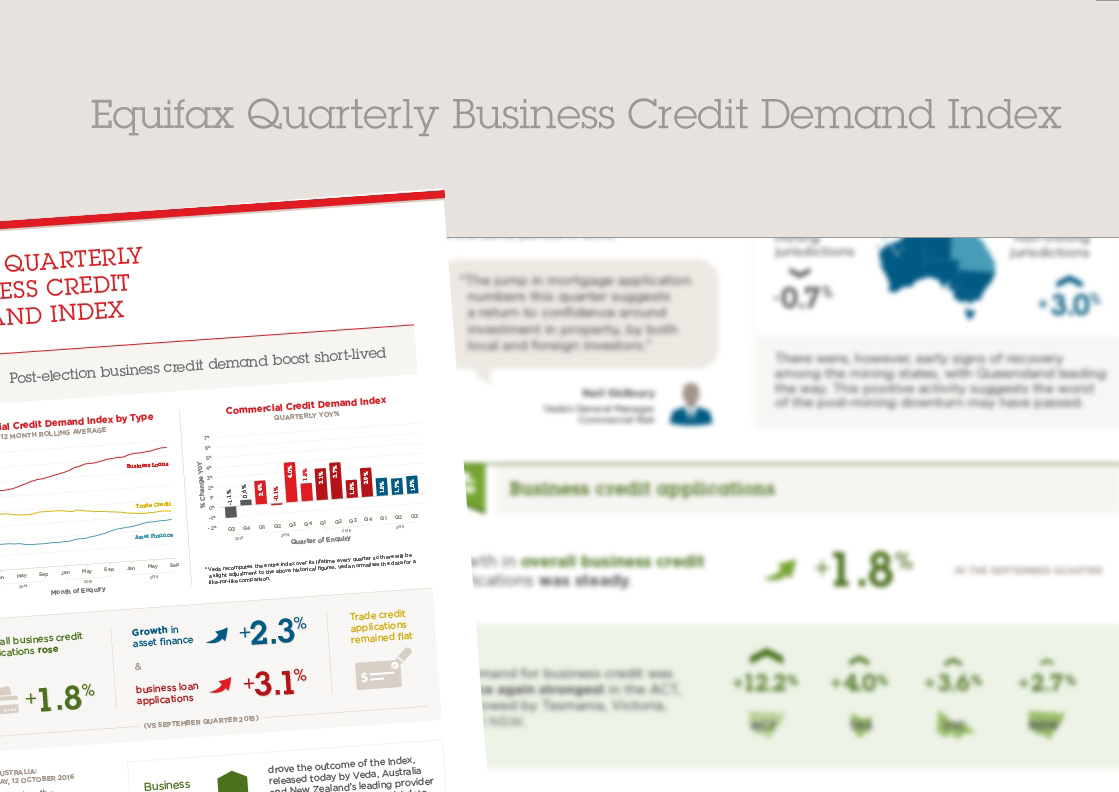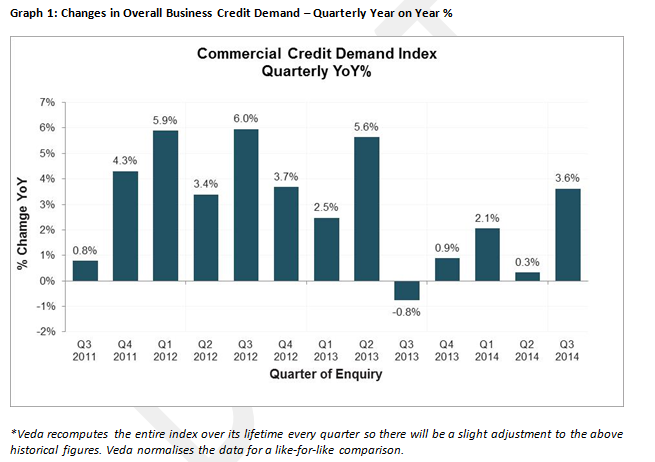Appetite for business credit lifts in Q1 2014, led by non-mining sectors

Veda Quarterly Business Credit Demand Index: September 2014
- Overall business credit applications rose 3.6% for the September quarter 2014 (vs September quarter 2013)
- Growth in business loan and trade credit applications, particularly in non-mining sectors in September quarter
- Decline in asset finance (-2.7%) although rate of contraction eased (vs September quarter 2013)
Sydney, Australia: 21 October 2014 – The Veda Quarterly Business Credit Demand Index, measuring applications for business loans, trade credit and asset finance, rose at an annual rate of 3.6% in the September quarter indicating a positive outlook for business.
This increase is reflected in strong rises in business loan applications (+6.7%) and trade credit applications (+4.9%), partially offset by a modest slide in asset finance applications (-2.7%).
Veda’s General Manager Commercial Credit, Moses Samaha, said: “Overall business credit conditions are the strongest we’ve seen since mid-2013, with business loan demand growing at 6.7% and trade credit up almost 5%.
“While asset finance decreased by 2.7%, the decline is on a slower trajectory. The drag on asset finance can be partly attributed to a contraction in autofinance activity.
“The economy is adjusting to life after the mining boom, with the recent lift in business credit demand coming from outside the mining industry. With low interest rates and business confidence rising, the non-mining sectors that are sensitive to interest rates such as retail and housing construction are starting to pick up,” he said.
“Investment prospects in these non-mining sectors are being further stimulated by solid economic growth, business profitability and the recent fall in the Australian dollar.”
Mr Samaha said increased marketing activity by major lenders also drove demand for business loan applications in the September quarter.
Released today, the Veda Business Credit Demand Index has historically proven to be a lead indicator of how the overall economy is performing.
Overall business credit applications picked up in all states and territories in the September quarter with an overall increase of 3.6%. The best performing states were NSW (+5.2%) and Tasmania (+6.0%), followed by Victoria (+3.4%), Queensland (+3.1%) and the NT (+3.4%). Comparatively weaker demand was seen in WA (+1.5%), SA (+1.6%) and the ACT (+1.5%).
The state most exposed to the mining industry downturn, WA, show a marked improvement compared to the previous four quarters. On the eastern seaboard, NSW has benefited from low interest rates with housing construction picking up.
Business loan applications continued to show solid improvement (+6.7%). The strongest growth was in Queensland (+9.0%), NSW (+8.3%), Victoria (+7.7%), SA (+6.6%) and NT (+9.7%). Moderate to weak growth was seen in the ACT (+3.2%) and Tasmania (+0.6%). WA (-2.5%) is the only state that still recorded a decline in business loan applications.
Within business loans, commercial mortgage applications (+6.4%) eased substantially from peak growth rates of almost 40% in late 2013. Applications were solid for lending proposals (+11.1%), credit cards (+21.5%) and overdrafts (+17.8%).
Trade credit applications also picked up strongly in the September quarter (+4.9%). Solid growth in trade credit applications was seen in WA (+9.0%), Queensland (+7.45%), NSW (+5.4%), the ACT (+6.3%), Tasmania (+17.4%), NT (+3.3%) and, while Victoria (+0.9%) and SA (+0.2%) experienced modest growth.
"Mining states have outpaced non-mining states in trade credit demand, with the strongest growth we have seen since mid-2010. These states are moving beyond the construction phase of the mining boom into an operational phase and that appears to be fueling increased transations between businesses for goods and services,” Mr Samaha said.
Asset finance applications softened in the September quarter (-2.7%), although the rate of contraction has eased since the June quarter (-4.9%). NSW (+0.7%) and Victoria (+0.5%) were the only states to see an increase in applications.
Within asset finance, commercial rental (+5.8%) and leasing (+1.5%) showed positive growth, while the rate of contraction in hire purchase applications (-1.5%) eased. Personal loan (autofinance) applications were down (-10.1%).
“Growth in the Australian economy was running at 3.1% in the June quarter of 2014. Given the historical relationship between the Veda Business Credit Demand Index and growth in real GDP, Veda’s latest business credit data would indicate growth in the Australian economy of around 3¼ to 3½%,” Mr Samaha said.

NOTE TO EDITORS
The Veda Quarterly Business Credit Demand Index measures the volume of credit applications that go through the Veda Commercial Bureau by credit providers such as financial institutions and major corporations in Australia. Based on this it is a good measure of intentions to acquire credit by businesses. This differs to other market measures published by the RBA/ABS, which measure new and cumulative dollar amounts that are actually approved by financial institutions.
DISCLAIMER
Purpose of Veda Indices releases: Veda Indices releases are intended as a contemporary contribution to data and commentary in relation to credit activity in the Australian economy. The information in this release does not constitute legal, accounting or other professional financial advice. The information may change and Veda does not guarantee its currency, accuracy or completeness, and you should rely on your own analysis and applications. Veda has relied on third party information in compiling the Indices and has not been able to independently verify the accuracy of that information. To the extent permitted by law, Veda specifically excludes all liability or responsibility for any loss or damage arising out of reliance on information in this release and the data in this report, including any consequential or indirect loss, loss of profit, loss of revenue or loss of business opportunity.
